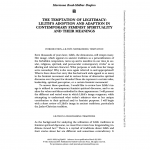This article surveys the many and various manifestations of Lilith’s image in the femenist spirituality in the last decades, in the Jewish world and beyond. The article examines the values and messages embodies in the adoption and adaptation of this figure, and reveals their contradictory character – in many fields. Finally, the conclusion is that Lilith’s figure constitutes an instrument to establish legitimation.
The article is about 7,600 words, in English.
In addition to this article, there are more items – an article and lectures that present the research project on Lilith. See links below.
“I cannot remember now how I had even heard of Lilith, but I borrowed her tale because it fit my contemporary need.”
from: Judith Plaskow (ed. Donna Berman), The Coming of Lilith: Essays on Feminism, Judaism, and Sexual Ethics, 1972-2003, p. 86.
Abstract
Lilith’s career begins as a lower-status demon in ancient Sumer (3rd millenia B.C.), but in some Kabbalistic circles, Lilith becomes a part of the divine Pleroma, heading the impurity forces besides Samael. Anyway, with all the popularity and her high-status, Lilith’s image in various cultures and traditions was almost always portrayed as evil, in the context of sins, defilement, and danger.
However, since the 1970s, Lilith features as a positive figure in the feministic spiritual discourse. For the first time, she is venerated – either as a positive model figure, or as an anti-hero in a story needed to be re-told and re-interpreted to reveal the injustice caused to her. Lilith features in this discourse in many ways: computer games, sexual magic rituals, feministic academic research, and more.
In this vibrant arena of current alternative spiritualities, a new feminine archetypical image emerges, representing diverse (even opposing) feministic values. In my paper, I wish to exemplify this field in which her image is re-formed as a source of inspiration for spiritual practitioners, as well as to analyse the vast difference between the multitude of formation of her (formerly-) dark image into a venerated symbol, and the implications of the adoption and adaption of these images.
Language
English
Academic/Non-academic
Academic
Publisher/Source
Modern Judaism – A Journal of Jewish Ideas and Experience
MJ is one of the most prominent journals in the field of modern Judaism, and has been published since 1981, by Oxford University Press.
Scimago Journal & Country Rank (SJR) places it in five different disciplinary categories. In 2017, Q1 in the Religious Studies category, Q2 in the Cultural Studies category, Q1 in the History category.
Bibliographical citation
Ruah-Midbar Shapiro, Marianna, “The Temptation of Legitimacy – Lilith’s Adoption and Adaption in Contemporary Feminist Spirituality”, in Modern Judaism – A Journal of Jewish Ideas and Experience 39.2 (May 2019): 125-143.






